This page was created on the basis of a study paper written in 1997 by Holger Wolpensinger at the University of Karlsruhe (it is available here in the Long version). Example number 10 (completion 2005) was added later. All settlements have been realised with more far-reaching ecological-sustainable objectives. The construction costs of the Ecological Settlement in Karlsruhe stand out somewhat because it is the only settlement of the 10 examples that has built an underground car park (semi-subterranean). Settlements No. 1 and 3 were built as part of the "Wohnmodelle Bayern" model project and focused on "low-cost construction with wood".
* Please note the year of completion!
| Project photo |
Name and short info |
Size |
Reference
year |
Construction costs *
|
|
|
1.
|
 |
Wooden housing estate "Ingolstadt" Permoserstrasse (Siedlungsmodelle Bayern), Archi. Widmann and Schröder www.sdg21.eu/db/holzbausiedlung-permoserstrasse-in-ingolstadt |
132 CU
+2 Gem. houses |
1994
|
795 €/m2
|
|
2.
|
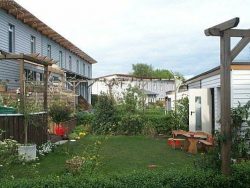 |
"Simple and self-build" self-build housing estate Lünen. 1,464 €/sqm complete incl. land (ground lease), development, ancillary costs. Own work share on average: 13,750 €/WE www.sdg21.eu/db/einfach-und-selber-bauen |
30 CU
|
1997
|
840 –
884 €/m2 |
|
3.
|
Wooden housing estate Sulzbach-Rosenberg, Grafmühlstraße. Architects: Fink + Jocher, Munich. Model project: "Living in timber construction". |
36 CU
|
1995
|
879 €/m2
|
|
|
4.
|
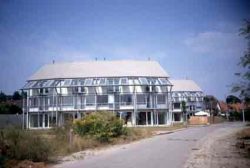 |
Solar garden Munzingen near Frbg., Rolf Disch www.sdg21.eu/db/solargarten-munzingen |
10 WE
|
1993
|
950 €/m2
|
|
5.
|
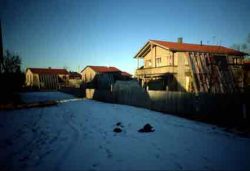 |
Lichtblick-COOP Leutkirch, A. Dransfeld, thermal insulation made of Kali-Wasserglasged wood chips, wood chip individual stoves, solar collectors, prefabricated timber panel construction, high own contribution possible due to simple timber construction details. The construction costs were between 775 €/m2 and 1.250 €/m2 www.sdg21.eu/db/coop-leutkirch |
6 CU
|
1995
|
950 €/m2 |
|
6.
|
 |
"Moorwiesensiedlung" in Kiel-Hassee, Werkgemeinschaft für Architektur + Städtebau (Heidrun Buhse, H.Schulze, a.o.), community house, kindergarten, archi.büro, reed sewage treatment plant, compost WC's, no concrete ceilings, wooden studs, loam, BHKW, social housing concept www.sdg21.eu/db/moorwiesensiedlung-kiel-hassee |
21 WE
|
1994
|
1.100 €/m² ** |
|
** incl. self-help + approx. 250 € for
Community facilities (incl. supply and disposal) |
|||||
|
7.
|
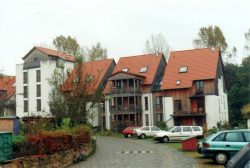 |
"Waldquelle", Bielefeld source, architect: Hans-Friedrich Bültmann, BHKW, local heating network, compost toilets, own drinking water source, partly a lot of own contribution www.sdg21.eu/db/bielefeld-waldquelle |
130 CU
|
1996
|
1.100 €/m²
|
|
8.
|
 |
Building Biology Settlement "Schafbrühl" Tübingen: Eble, Sambeth, Oed, Häfele, Tübingen, GFZ 0.9 www.sdg21.eu/db/baubiologische-siedlung-schafbruehl |
111 CU
|
1985
|
1.223 €/m²
|
|
9.
|
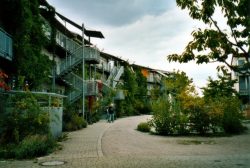 |
Ecological settlement "Geroldsäcker", Karlsruhe: workhouse, community house, food co-op, fairground, car-free settlement area, playground, solar architecture www.sdg21.eu/db/oekologische-siedlung-geroldsaecker |
40 CU
|
1993
|
1.300 €/m²
|
|
10.
|
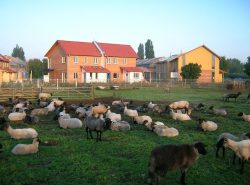 |
Berlin Adlershof: Building owners' association "LEBENS(t)RAUM Johannisthal www.sdg21.eu/db/am-rundling |
15 CU
|
2005
|
1.085 €/m² ***
|
| *** (KG 300 + 400 related to living space) 1,550 €/m² including construction costs, ancillary construction costs, land acquisition plus land transfer tax and notary as well as builder's costs during the construction period |
|||||
Which construction costs are meant?
In addition, it should be noted that in most publications it is not specified exactly which construction costs are meant. With or without land? Gross or net? With cellar or from upper edge cellar (in the prefabricated house construction e.g.), ... etc.. In this text I give these details, as far as they were given in the source texts.
Principles for ecologically cost-effective construction
1. redeployment of existing funds to finance otherwise "too expensive things", e.g. instead of several cars a car-free housing concept with car sharing and a CHP. This is a better service and the more ecological.
2. if conventional building and settlement technologies can be replaced by ecological ones, the ecological variant will even be more cost-effective than the conventional one in some areas (e.g. decentralised drainage).
3. multiple use, functional mixture of a building element: permaculture principles in building and settlement planning
Ecological planning right from the start
* Integral planning with competent engineers, technicians, etc. from the earliest possible stage, i.e. including ecological concepts and technologies from the very beginning. The later planning changes are made, the more expensive they become.
* professional participation: later changes are much more complex and expensive. The moderation costs in 4 years of the model project Carfree Living Bremen-Hollerland are mentioned with less than 0,5 % of the investment sum for the construction of the settlement with altogether more than 200 flats.
* Process control/ cost control/ quality assurance/ project management
* good urban land use planning
* Excavated earth (basements) and debris (asphalt and old barracks) should be used on the site for landscaping, if possible.
Building construction/ building structure
* Wooden stud wall with thermal insulation is thinner than a solid wall with the same k-value, thus providing more living space.
* no dry living!
* Board stack ceilings and walls (according to J.Natterer)
* Wooden houses are lighter, smaller foundation
* (floor) ducts not necessary: construction-related cavities in timber construction save approx. 15 €/sqm
* Modular construction/ grid system/ high degree of prefabrication (wooden studs)
* compact building structure
* flat monopitch roof: only one drainage, simple static system
* constructive instead of chemical wood protection (weather-resistant wood species such as oak, Douglas fir, etc.)
* Limitation to a few materials
* Mass rabble-rousing
* Price comparison of wall constructions with the same k-value (data from LBTA lecture):
Wooden construction: 92 €/sqm (100%) (wooden post and beam construction with conventional thermal insulation infill)
Masonry: 105 €/sqm (114%)
Core insulation: 180 €/sqm (195%) (11.5 cm KS, 4 cm air, 8 cm Styropor, 17.5 cm KS, interior plaster)
Note: the prices are, however, very strongly regionally and seasonally fluctuating. If the carpenter has a lot of work, but the bricklayer has little to do, the masonry wall may be cheaper. Furthermore, cost advantages due to prefabrication in timber construction are compensated by cheap labour.
Building
* Rationalization on construction site, e.g. plastering machine, blow-in insulation material, ...
* qualified entities
Construction cost considerations on trades or settlement concepts
Clay
* Costs and economic efficiency
Already today, an earthen house, i.e. a house in which earthen building materials are largely used, is no more expensive than a conventionally built house and this in professional execution by companies. With the supply of earthen building materials on the construction market - now in its infancy - their use will become more natural and safe, and the growing demand will contribute to the competitiveness of earthen products in wide areas.
A comparison of material prices with other building materials shows that earthen building materials can be cheaper today and still fulfil the same purpose. However, it must be taken into account that most earthen building materials can only be used for non-load-bearing applications. As infill materials for skeleton construction and timber frame renovation, many earthen building materials are already superior to conventional building materials in terms of price.
* Processing in self-help
Most earth building materials and methods are particularly well suited to self-help. The techniques are easy to learn and not too physically demanding, so that lay people, helpers, friends and the whole family can be used.
* Standards
The earthen building DIN, which was withdrawn in 1971 because it was "outdated", is currently being revised and will be reintroduced. This is an important contribution to reduce costs.
* Rating
In summary, it can be said that there is hardly any other building method that corresponds to today's ecological, physical and health considerations as well as earth building, which, however, is only beginning to be developed into a modern building method through the initiative of individuals.
[S. 121 (12)]
Roof plantings
Planted roofs store up to 90% of rainwater and release the runoff (10%) with a delay. This has the advantages that the sewage network and sewage treatment plants are not burdened, rain overflow basins are not necessary with widespread greening, receiving waters (amtsdeutsch: "streams and rivers") are not burdened and the groundwater level does not sink. Roof plantings absorb pollutants from the air and improve the microclimate, since in summer only 8% of the solar radiation is reflected again. This means that the roof structure only heats up slightly in contrast to bitumen roofs, for example, which can reach temperatures of up to 60 degrees during hot spells and when the sun is shining strongly. The strong temperature fluctuations of bitumen roofing lead to high maintenance requirements and associated costs.
Car free living
* With a number of parking spaces of 0.2 /WE for 300 WE, the construction of 240 parking spaces is saved. If these were underground car parks, this corresponds to 240 x 20,000 € = 3.6 million €, which can be saved or used for other purposes.
* Life without own car saves on average approx. 75 to 150 € per month [Verkehr in Zahlen 1989] or in extreme cases: up to 1,500 € per month [Mercedes 600S; Bad. Zeitung 23.3.94] with the same annual mileage of 13,000 km by federal railway, public transport, car sharing, taxi, bicycle, walking and delivery of large items such as furniture.
Development
* Car-free development with narrower and less paved, open-paved bike and pedestrian paths that can only be used for ambulances, etc., are cheaper than paved roads.
* Develop settlements as large parcels. This allows, for example, a common trench for electricity, water, sewage, vacuum toilets, TV cable, telephone, etc... which would otherwise be laid in extra trenches. A Tel. - and TV main connection in the settlement and the subsequent internal distribution is cheaper than to connect each apartment separately and has the advantage of free telephoning within the settlement.
Energy
Examples of proven economically implemented energy technologies:
* Energy-saving household appliances:
An energy and water saving washing machine saves between 140- 1200 € in 15 years lifetime
Electricity-saving refrigerator saves between €345 and €1,560 in operating costs in 15 lifetimes
* Swimming pool absorbers more cost-effective than conventional burners
* Biomass, such as straw firing plants, wood chips, biogas plants in sewage treatment plants,...
* Wood chip CHP plants, biogas CHP's, wood gasification plants,...
* Low-energy houses: additional costs due to additional insulation between 2.1 and 8.4% [Study IWU, Darmstadt; p.228 (4) ]
* Passive House: additional construction costs of the pilot project Kranichstein amount to 286 €/sqm living space, about 16% of the pure construction costs. With an improved, slimmed-down variant (abandonment of inefficient techniques that did not produce the expected results in the pilot project), the additional construction costs would fall to below 13% of the construction costs [p.230 (4) ].
* Solar local heating
Ravensburg: 50% Cost reduction for large-scale collector system and local heating pipe compared to individual systems on each building
Hamburg.Bramfeld: Use of prefabricated solar roof collectors. Collector as roof covering
The price per square metre of installed collector area is only a quarter of what small systems cost, at around €250 for systems of this size (such as Friedrichshafen-Wiggenhausen (4450 square metres of collector area) or Hamburg-Bramfeld (3520 square metres). At about 26 Pf./kWh of solar heat, such plants will soon be in the realm of economic competitiveness." [p.128 art. "Integral Energy Concepts in Germany" by N.Fisch and A.Lutz in "Solar Architecture for Europe", ed. Astrid Schneider, 1996]
World's largest project is in Marstal Fjernvarme, Denmark with 8000 sqm collectors and 2100 m3 buffer tank with specific heat price with 7 Pf/ kWh, which corresponds to heat production prices of oil or gas. The plant supplies 13% of the annual heat demand. In the 3 summer months 100%.
Social
* Jointly used facilities save money (community house, car sharing, workshops, offices, photo lab, sauna, guest room, children's playroom, multi-purpose rooms, laundry room, ...) and, if well planned, reduce the space requirements in the individual apartments. In return, there is a greater organisational effort (rules) and more communication is necessary.
The cohousing project "Jystrup Savvaerket", Denmark
21 residential units, occupation: 1984, community house 404m2, residential street 795m2
The special feature of this cohousing project is the residential street covered as a glass gallery. In previous projects without glazing, the community house activities always dropped sharply in winter. For the usability of the common rooms it is important that one can "briefly go over" even in a jogging suit. The glass roof protects the residential street from the weather and allows the common rooms to be used all year round.
* Self-management saves administrative costs
Building Biology
* PVC-free cables with shielding against electric fields have a higher material price (8 to 10 times). However, as the labour costs account for the major share, the additional costs only amount to approx. 2% of the total costs for halogen-free cables and 6- 8% for halogen-free and shielded cables. Much more important is the thoroughness of the planned cable routes and the supply concept. Here, intelligent planning can halve the amount of material. This is where costs can really be saved. [Data from (12) section 5.4]
* …
Funding
* Muscle mortgage through self-help can help save capital costs, but beware: realistic assessment of capacity is important to avoid construction delays and associated additional costs.
* Least-cost planning
* Contracting
* Cooperative financing models
* joint borrowing by a community of builders
Funding
* Eco-bonus for energy saving measures, solar systems, etc. by the federal government
* building subsidies can be claimed, as for any other building project
* lower interest ethically sound loans at environmental banks, e.g. Ökobank Frankfurt, Umweltbank, Munich, GLS Bochum
* cost-covering remuneration for solar electricity enables the financing of photovoltaic systems
* Market introduction grants for new technologies
Cost reductions of ecological construction are to be expected through:
* greater demand
* Rationalisation of production
* Technical developments
* Standardization
* with increasing experience of the construction companies and craftsmen, "fear surcharges" are reduced or eliminated
* more prefabrication
* Quality improvement
* better marketing
* better information
* more competent planners
Construction costs
Comparing construction costs is difficult because often not all factors for the development of a price are known. In the following, three examples of how strongly the total construction costs differ regionally and in which areas there is great potential for savings.
When looking at the total costs of a study on a residential and commercial construction project, the high proportions for management, financing, developer and sales are particularly striking. A total of 31%. Thus, if significant savings are to be considered in our construction operations, thought must inevitably be given to task and risk allocation, contracting and execution times [p. 190 (4)].
Furthermore, greater cost reductions can be achieved in the economical use of building land than in saving on the quality of building materials. Approximately 25% of the construction sum goes on average into the land. Regional price differences can also be much more decisive for the total costs. For comparison: one sqm of building land costs
in Stuttgart: 750 Euro
in Karlsruhe: 275 €
in Bremen: 95 €
[imu, Stuttgarter Zeitung No.143]
Housing costs can also vary from region to region: a 3-room apartment with 70 sqm and medium housing value cost on average in 1997:
Düsseldorf: 158,000 € (approx. 2,250 €/sqm WF)
Stuttgart: 115,500 € (approx. 1,650 €/sqm WF)
Brunswick: 84,000 € (approx. 1,200 €/sqm WF)
[imu, Stuttgarter Zeitung No.143]
This website is based on a student research project by Holger Wolpensinger. This is available here in the Long version.
